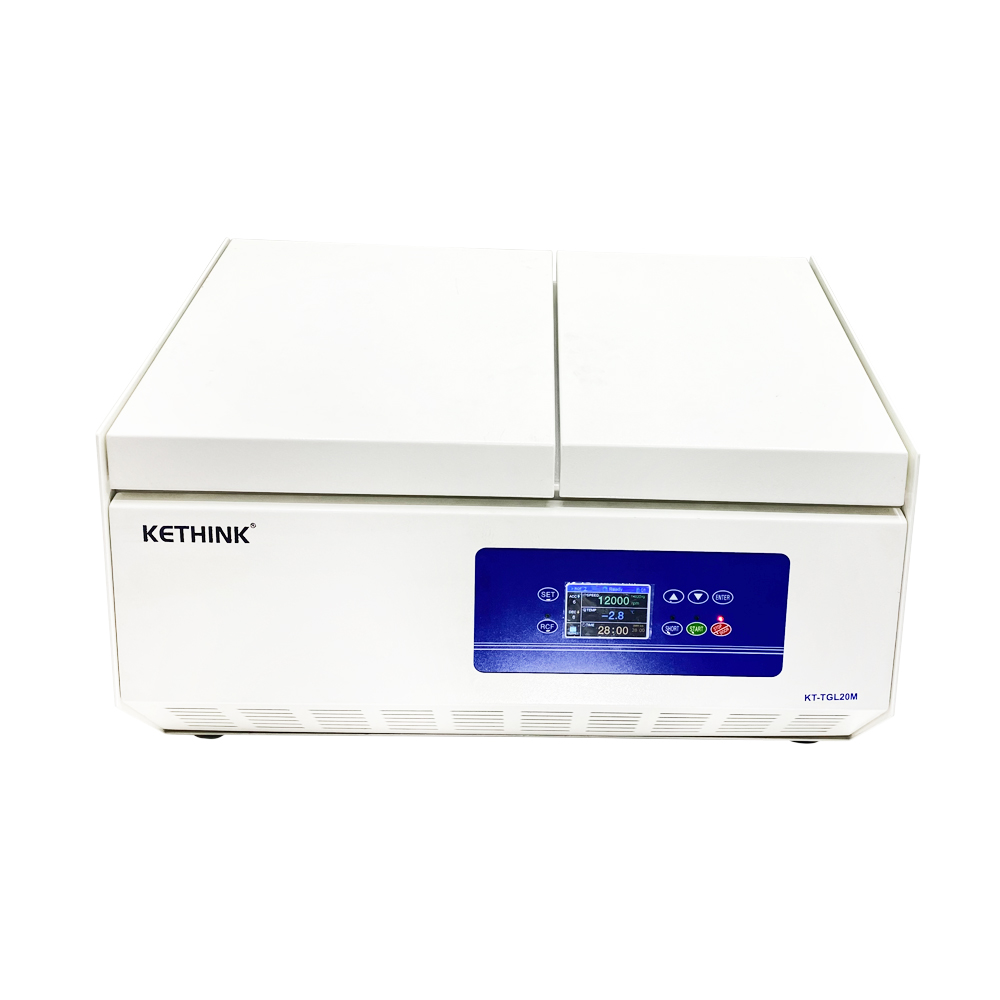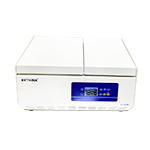Model NO: KT-TGL20M(LED) KT-TGL20MR(LCD)
Every PCR lab around the world needs to have an all-in-one PCR centrifuge to improve its workflow effeciency. The role of a PCR centrifuge is critical. It is Mainly used for blood centrifugation and nucleic acid extraction
from DNA and RNA samples. It helps to separate each component reach the bottom of the tube, making the final uniformity/ concentration. Everything comes to the solutions at the bottom.
KETHINK is happy to present the results of years of precision engineering combined with the high level reliable design that will satisfy the
most demanding PCR lab requirements.
Warranty: 1 year for free,technical support for life
Delivery: within 10-15 working days
Support: free trainning, online technical support
Knowledge About PCR & PCR lab
The PCR laboratory is also called the gene amplification laboratory. PCR stands for “Polymerase Chain Reaction”. It is a molecular biology technique used to amplify specific DNA fragments, which can be seen as a special DNA replication in vitro. Through the DNA gene tracking system, the virus content in the patient’s body can be quickly grasped, and its accuracy is as high as nanometers.
In the sample preparation sector of a PCR lab, a high speed centrifuge & a mini centrifuge are lab necessary equipments used for nucleic acid (RNA, DNA) extraction, storage and adding to the amplification reaction tube.
PCR Centrifuge Use
1) DNA Extraction for Sample Preparation
- What is human blood DNA extraction
- DNA stands for “DeoxyriboNucleic acid”,it is the main component of chromosomes and also an important genetic material. DNA extracted from human blood can be used for scientific research, preparation of seedlings, antibodies, and DNA grafting (recombination) experiments.
- DNA extraction process
- Melt frozen blood at room temperature;
- Transfer 1 ml of blood into a sterile 2 ml centrifuge tube, add an equal volume of PBS phosphate buffer, mix well and centrifuge at 12000 rpm for 5 min, discard the supernatant;
- Add 667μl STE, 24μl 20% SDS, 37℃ water bath for 1 h;
- Add 10µl of 20 mg/ml proteinase K and mix well, digest in a water bath at 55°C overnight (10-14 h);
- Add an equal volume of Tris saturated phenol to the digested sample, shake well, and centrifuge at 12000 rpm for 10 min;
- Transfer the upper aqueous phase to another sterile 2 ml centrifuge tube; then add an equal volume of Tris saturated phenol, shake well, and centrifuge at 12000 rpm for 10 min;
- Transfer the upper aqueous phase to another sterile 2 ml centrifuge tube; and add an equal volume of chloroform: isoamyl alcohol (24:1), shake and mix thoroughly, and centrifuge at 12000 rpm for 10 min;
- Place the sample in the refrigerator at -20°C for 30 minutes or ice bath for 15-20 minutes, take it out and centrifuge again at 12000 rpm for 10 minutes to precipitate the DNA;
- Use a pipette tip to pick the DNA into another sterile centrifuge tube, wash with an appropriate amount of 70% ethanol and shake to wash out the DNA impurities;
- Pour out the ethanol, dry the DNA in a vacuum or air dry, add an appropriate amount of TE buffer to re-dissolve it, and store at -20°C for later use.
- DNA extraction protocol
- centrifuge at 12000 rpm for 10 min.
2) RNA Extraction for Sample Preparation
- What is blood RNA extraction
- RNA stands for “Ribonucleic Acid”, it is the genetic information carrier that exists in biological cells and some viruses and viroids.
- Methods of RNA extraction
- Sample Pre-treatment
- ①1ml whole blood + 1ml RNase-free ddH2O.
- ②The RNA blood preservation solution was centrifuged at 12000 rpm for 5 min, the supernatant was discarded and 1 ml of RNase-free ddH2O was added.
- ③200 microliters of whole blood + 1 ml of RNase-free dd H2O.
- ④500 microliters of whole blood + 1500 microliters of TRIzol (3 times the sample volume), mix thoroughly.
- NOTE:All samples are placed at 15-30°C for 5 minutes. ①②③The sample was centrifuged at 12000 rpm for 10 min at 4℃.
- Homogenization
- ①②③ Discard the supernatant, add 1 ml of TRIzol, and mix well. Place the sample ①②③④ at room temperature for 5 minutes. Centrifuge at 12000 rpm for 10 min at 4°C. Take the supernatant to a new 2 ml centrifuge tube, add 2 times the volume of phenol: chloroform: isoamyl alcohol (25:24:1), shake vigorously for 15 seconds, and leave it at room temperature for 3 minutes to allow it to separate naturally. NOTE: After adding TRIzol, if subsequent experiments are not required, the sample can be stored at -70°C for long-term storage.
- RNA Precipitation
- 1.Centrifuge at 12000 rpm for 10 min at 4°C.
- NOTE: The sample will be divided into three layers: the yellow organic phase, the middle layer and the colorless water phase. The RNA is mainly in the water phase. Transfer the water phase to a new tube. Do not aspirate the intermediate interface, otherwise it will cause DNA contamination in the RNA sample.
- 2.Pipet the supernatant into a new centrifuge tube, add an equal volume of ice isopropanol, and leave it at room temperature for 20-30 minutes. Centrifuge at 12000 rpm for 10 min at 4°C. The RNA is deposited at the bottom of the tube.
- RNA Wash
- 1. Discard the liquid, add the same volume of 80% alcohol as TRIzol (prepared with RNase-free ddH2O), slowly turn upside down to suspend the precipitate.
- 2. Centrifuge at 12000 rpm for 3 min at 4°C. Discard the liquid and leave it at room temperature for 30 minutes (the liquid should only evaporate, it should not be left for too long, as the RNA sample will be difficult to dissolve if it is too dry).
- Redissolving the RNA
- Add 30-100 microliters of RNase-free ddH2O to the precipitate, and mix well by pipetting. Long-term storage at -70℃.
- Sample Pre-treatment
- RNA extraction protocol
- Centrifuge at 12000 rpm for 10 min at 4°C.
| Model | KT-TGL20M(LED) KT-TGL20MR(LCD) |
| Max Speed | 20000 rpm |
| Max RCF | 28948xg |
| Max Capacity | 6*100ml |
| Speed Accuracy | ± 10rpm/min |
| Temperature Range | -20°C ~ +40°C |
| Temperature Accuracy | 土1°C |
| Display | LED/LCD |
| Timer Range | 1-99m/9h59min |
| Motor | brushless frequency conversion motor |
| Power Supply | AC 220V 50HZ 10A |
| Compressed units | Imported environmentally friendly refrigerant |
| Power | 1200W |
| Noise | ≤62db |
| Device Dimension | 95 kg |
| Net Weight | 510* 630*380mm(L* W* H) |
Rotors (optional)
| NO | ITEM | MAX SPEED (rpm) | MAX RCF (xg) | VOLUME(ml) | TUBE SIZE (mm) |
| NO.1 | Angle rotor | 20000rpm | 28948xg | 12*1.5/2.2ml | Φ10*42 |
| N0.2 | Angle rotor | 16000rpm | 20653xg | 24*1.5/2.2ml | Φ 10*42 |
| NO.3 | Angle rotor | 14000rpm | 19450xg | 30*1.5/2.2ml | Φ10*42 |
| N0.4 | Angle rotor | 13000rpm | 17930xg | 48*1.5/2.2ml | Φ10*42 |
| NO.5 | Angle rotor | 18000rpm | 26635xg | 30* 0.2/0.5ml | Φ8*30 |
| N0.6 | Angle rotor | 14500rpm | 21807xg | 48*0.2/0.5ml | Φ8*33 |
| NO.7 | Angle rotor | 15000rpm | 19350xg | 8/10*5ml | Φ14*54 |
| N0.8 | Angle rotor | 15000rpm | 19350xg | 16* 5ml | Φ14*54 |
| N0.9 | Angle rotor | 15000rpm | 13856xg | 3*8*0.2ml (PCR tube) | Φ6*22 |
| NO.10 | Angle rotor | 14000rpm | 12826xg | 6*8 *0.2ml (PCR tube) | Φ6*22 |
| N0.11 | Angle rotor | 14000rpm | 16370xg | 12*7ml | Φ15*62 |
| N0.12 | Angle rotor | 14000rpm | 16460xg | 6*10ml | Φ16* 87 |
| N0.13 | Angle rotor | 15000rpm | 22680xg | 12*10ml | Φ16*87 |
| N0.14 | Angle rotor | 15000rpm | 22680xg | 8*15ml | Φ16*118 |
| N0.15 | Angle rotor | 5000rpm | 3515xg | 24* 15ml | Φ16*118 |
| N0.16 | Angle rotor | 5000rpm | 3830xg | 30*15ml | Φ16*118 |
| NO.17 | Angle rotor | 15000rpm | 22680xg | 8*20ml | Φ22*104 |
| N0.18 | Angle rotor | 14000rpm | 19060xg | 6*30ml | Φ25*94 |
| NO.19 | Angle rotor | 13500rpm | 18950xg | 4*50ml | Φ29*106 |
| NO.20 | Angle rotor | 13000rpm | 18840xg | 6*50ml | Φ29*106 |
| N0.21 | Angle rotor | 10000rpwm | 10813xg | 6*70ml | Φ32*150 |
| NO.22 | Angle rotor | 12000rpm | 15635xg | 4*100ml | Φ37*124 |
| NO.23 | Angle rotor | 10000rpm | 11380xg | 6*100ml | Φ37*124 |
| NO.24 | Angle rotor | 12000rpm | 15869xg | 24 pcs capillaries | Φ4*100 |
| NO.25 | Horizontal ELISA plate rotor | 4000rpm | 2310xg | 2*2*48ml |


